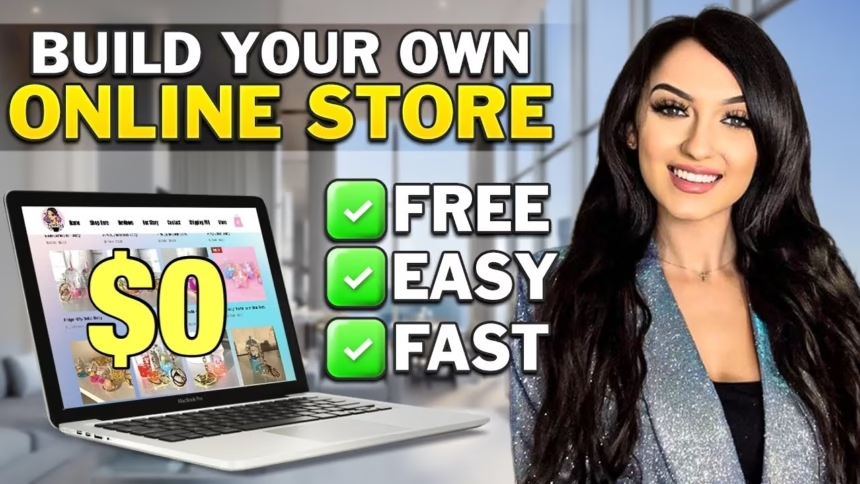Do you dream of selling your creations, vintage finds, or just clearing out clutter, but the thought of building a full e-commerce website seems too expensive and complicated? That used to be the only path for serious sellers. Now, things have changed dramatically.
You absolutely can create an online store without a website and start making sales right away, often for free. Maybe you’re a beginner testing a business idea, someone selling just a few items as a side hustle, or an artist who only needs a simple storefront. You don’t need domain names, hosting fees, or complex coding.
Many successful businesses skip the traditional website entirely, using platforms where millions of customers already shop. These platforms provide the tools, the audience, and often the payment processing systems you need. Forget the $5,000 upfront cost of a bespoke website. The primary goal is simple: discover the easiest, zero-cost paths to list your products and start earning money today.
Your Profile is Your Store: Selling on Social Media for Free
Social media is the fastest way to start selling because that’s where all the people are. Platforms like Facebook and Instagram offer built-in marketplace tools or, at the very least, allow you to use a free profile as your storefront. We focus here on solutions that are genuinely zero-cost to start listing items and connecting with buyers.
Facebook Marketplace: The Top Spot to Sell Locally and Avoid Shipping
Facebook Marketplace is a crucial tool for anyone looking to sell used or large items quickly. Its main benefit is that listing items is completely free. This platform excels at connecting you with local buyers.
It’s the perfect solution for selling large goods like furniture, used electronics, or exercise equipment that you don’t want to ship. Transactions are typically simple cash exchanges or direct transfers (like Zelle) upon pickup. This reduces your logistical headaches and keeps your costs at zero. If you’re planning on selling big items, Marketplace is the first place you should look.
Instagram Shopping: Turning Good Photos into Easy Cash
Instagram is perfect if your products are highly visual, such as handmade jewelry, unique clothing, or original art. You don’t need the slightly more formal (and sometimes fee-based) ‘Shops’ feature to start successfully selling.
You can use a standard, free business or creator profile. The strategy here is simple: post high-quality, engaging pictures of your products. Include a compelling description, a price, and a clear call-to-action that instructs buyers to send you a DM (direct message) to complete the purchase. You can then finalize the transaction using simple payment apps like PayPal or Venmo. This setup allows you to test your market and build a following. Learn more about how to monetize Instagram for a Side Hustle using a similar approach.
Dedicated Selling Apps: Your Free Digital Market Stall
Dedicated selling apps act as managed digital marketplaces. Unlike social media, these platforms handle some of the logistics for you, like payment collection and sometimes even generating shipping labels. The key advantage is that they are generally free to list items; they only take a small commission after you make a successful sale.
Mercari and Poshmark: Easy Ways to Ship Clothes and Small Goods
Listing items on platforms like Mercari and Poshmark is free, making them great entry points for small-scale sellers.
- Poshmark is heavily focused on fashion and brands. It has a high volume of buyers looking for clothing. While its fees can be higher, it simplifies sales for brand-conscious apparel sellers.
- Mercari handles a wider variety of inventory, from collectibles to household items and general goods. Their fees are often slightly lower than Poshmark’s.
Both platforms offer a huge benefit for beginners: they provide prepaid shipping labels. This makes mailing packages much simpler. You just print the label, stick it on the box, and drop it at the post office; you don’t need a separate shipping account.
Nextdoor: The Best Free Option for Selling Big Items to Neighbors
Nextdoor is a community-focused platform. It is excellent if you want to sell larger, bulkier items (like tools, appliances, or large home décor) but don’t want the hassle of listing on a giant platform like Facebook Marketplace.
Nextdoor is specifically designed for local communities. It is completely free to list items and connect directly with neighbors. Since you’re selling to people nearby, you avoid shipping costs entirely and manage simple, local pick-up transactions. This is a secure and low-effort way to liquidate certain types of inventory.
Etsy and Depop: Starting a Brand with Low-Cost Options
For sellers ready to scale up slightly, Etsy and Depop offer brand-building potential with minimal upfront costs.
Etsy is the clear leader for serious handmade goods, unique crafts, and vintage items. While it has a very small listing fee (a fraction of a dollar per item), it is worth the investment if you are serious about your craft business. They sometimes offer free listing credits to new sellers, allowing you to try it out risk-free.
Depop is a strong option for vintage fashion, streetwear, and highly stylized items. It attracts a younger, fashion-forward audience. Depop only charges a 10% fee upon sale. This means it is still free to list and connect with buyers, making it an accessible way for fashion-focused sellers to create an online store without a website.
| Platform Type | Best For | Typical Transaction Method | Upfront Cost to List |
|---|---|---|---|
| Social Media (FB/IG) | Local sales, visual goods | Direct Message, Cash/Venmo | Free |
| Dedicated Marketplaces | Shipping small goods, variety | Integrated payments | Free (Fee only upon sale) |
| Niche/Brand Building | Handmade, Vintage Clothes | Integrated payments | Low/Minimal per listing |
The Simple Business Stuff: Getting Paid and Mailing Your Items
Once you’ve made a sale, the next step is safely handling the money and getting the product to the customer. Maintaining simplicity means keeping costs low for payment processing and shipping.
Zero-Cost Payments: How to Safely Take Money Online
For local sales, cash is king, but for selling across distances, you need secure online payment solutions. Fortunately, many options are free to set up.
Free payment solutions include PayPal and Venmo (owned by PayPal). Most dedicated marketplace apps (Mercari, Poshmark) handle the integrated payments directly, which simplifies things immensely. Payment safety is crucial. Always make sure the funds have cleared and are actually in your account balance before you ship the item. Avoid elaborate payment schemes or buyers who insist on unusual payment methods. Stick to major, established platforms; they offer the best protection for new sellers.
Packaging and Shipping Hacks to Save You Money
Shipping costs can quickly erase your profits, so smart packaging is essential.
One significant way to cut costs is by reusing and repurposing boxes and packing materials you already have. Check with local grocery stores or big box retailers; they often have stacks of clean boxes they are happy to give away. Additionally, if you use USPS Priority Mail, the boxes and envelopes are provided free of charge, as long as you use them for Priority Mail service.
Pay attention to how you print your shipping labels. If you use integrated platform labels (like those from Poshmark or Mercari), the process is straightforward, and insurance is usually included. If you print your own labels (often via PayPal or a service like Pirate Ship), you can sometimes save money on lighter packages, but you take responsibility for accurate weight and mailing class. Start with the platform’s label option first, as it’s the easiest way for a beginner to handle logistics.
Start Selling Today
The ability to create an online store without a website has never been easier or more accessible. You have powerful tools at your fingertips, whether you choose the rapid, local sales power of social media and Nextdoor or the nationwide reach and logistical support of platforms like Mercari and Poshmark.
The marketplace is waiting for your unique products. The single best action you can take right now is choosing one of the free platforms mentioned above, taking clear photos of your first item, and listing it. Don’t worry about perfection; focus on the sale. Get your first listing up, make your first dollar, and begin building momentum for your newly launched, nearly zero-cost online shop. Success starts with that first step.















